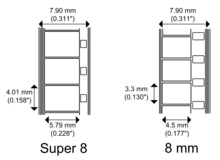This article needs additional citations for verification. (March 2023) |




Super 8 mm film is a motion-picture film format released in 1965[1][2][3] by Eastman Kodak as an improvement over the older "Double" or "Regular" 8 mm home movie format.

The film is nominally 8 mm wide, the same as older formatted 8 mm film, but the dimensions of the rectangular perforations along one edge are smaller, which allows for a greater exposed area. The Super 8 standard also allocates the border opposite the perforations for an oxide stripe upon which sound can be magnetically recorded.
Unlike Super 35 (which is generally compatible with standard 35 mm equipment), the film stock used for Super 8 is not compatible with standard 8 mm film cameras.
There are several varieties of the film system used for shooting, but the final film in each case has the same dimensions. The most popular system by far was the Kodak system.
- ^ Lenny, Lipton (1975). The Super 8 Book. San Francisco: Straight Arrow Books. p. 11. ISBN 0-87932-091-5.
In May 1965, super 8 in its stubby, coaxial plastic cartridge arrived loaded with Type A indoor balanced Kodachrome II, billed as a universal film.
- ^ Lipton, Lenny (1973). Independent Filmmaking (5. print (revised) ed.). San Francisco: Straight Arrow Books. p. 26. ISBN 0-87932-010-9.
After several years of research, Kodak offered super 8 format film in Instamatic cartridges in 1965.
- ^ Kodak. "Super 8 mm Film History". Kodak. Retrieved 12 February 2013.
In April of 1965, this revolutionary new format was introduced...